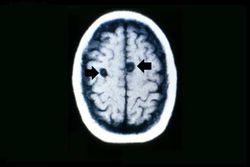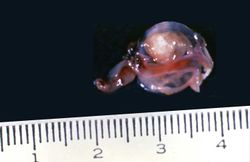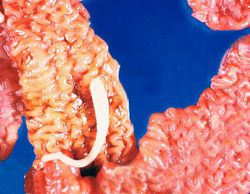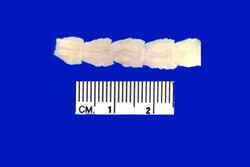Difference between revisions of "IPLab:Lab 11:Cysticercosis"
Seung Park (talk | contribs) |
Seung Park (talk | contribs) (→Images) |
||
| (7 intermediate revisions by 2 users not shown) | |||
| Line 1: | Line 1: | ||
== Clinical Summary == | == Clinical Summary == | ||
| − | This 29-year-old woman was admitted to the hospital because of repeated tonic-clonic seizures. The patient was a tour guide leading groups of tourist to Tibet for two-month walking/camping tours in the Himalayas. Her seizures were easily controlled by intravenous administration of phenytoin. The WBC count was 13,000, with 5% eosinophils | + | This 29-year-old woman was admitted to the hospital because of repeated tonic-clonic seizures. The patient was a tour guide leading groups of tourist to Tibet for two-month walking/camping tours in the Himalayas. Her seizures were easily controlled by intravenous administration of phenytoin. The WBC count was 13,000, with 5% eosinophils and the erythrocyte sedimentation rate was slightly elevated. A cranial CT performed with and without contrast revealed two ring-enhancing lesions. The patient underwent a craniotomy and excisional biopsy. |
| Line 13: | Line 13: | ||
File:IPLab11Cysticercosis4.jpg|This is a photograph of the body of an adult tapeworm. Note the body segments. | File:IPLab11Cysticercosis4.jpg|This is a photograph of the body of an adult tapeworm. Note the body segments. | ||
</gallery> | </gallery> | ||
| + | |||
| + | == Study Questions == | ||
| + | * <spoiler text="How did this patient get this parasite?">Cysticercosis is caused by the cestode parasite, Taenia solium (pig tapeworm). Cysticercosis is contracted by ingesting eggs from the feces of a person infected with an adult Taenia solium. The eggs can survive for several weeks in soil but are also infectious as soon as passed. The larvae migrate through the intestinal wall and are disseminated via the blood stream and can encyst in the brain, heart, skeletal muscle, or skin.</spoiler> | ||
| + | |||
| + | == Additional Resources == | ||
| + | === Reference === | ||
| + | * [http://emedicine.medscape.com/article/215589-overview eMedicine Medical Library: Cysticercosis] | ||
| + | * [http://emedicine.medscape.com/article/781845-overview eMedicine Medical Library: Cysticercosis in Emergency Medicine] | ||
| + | * [http://www.merckmanuals.com/professional/infectious_diseases/cestodes_tapeworms/taeniasis_solium_and_cysticercosis.html Merck Manual: Taeniasis Solium and Cysticercosis] | ||
| + | |||
| + | === Journal Articles === | ||
| + | * Garcia HH, Del Brutto OH. [http://www.ncbi.nlm.nih.gov/pubmed/10738675 Taenia solium cysticercosis]. ''Infect Dis Clin North Am'' 2000 Mar;14(1):97-119, ix. | ||
| + | |||
| + | === Images === | ||
| + | * [{{SERVER}}/library/index.php?/tags/1622-cysticercosis PEIR Digital Library: Cysticercosis Images] | ||
{{IPLab 11}} | {{IPLab 11}} | ||
[[Category: IPLab:Lab 11]] | [[Category: IPLab:Lab 11]] | ||
Latest revision as of 01:46, 30 August 2013
Contents
Clinical Summary[edit]
This 29-year-old woman was admitted to the hospital because of repeated tonic-clonic seizures. The patient was a tour guide leading groups of tourist to Tibet for two-month walking/camping tours in the Himalayas. Her seizures were easily controlled by intravenous administration of phenytoin. The WBC count was 13,000, with 5% eosinophils and the erythrocyte sedimentation rate was slightly elevated. A cranial CT performed with and without contrast revealed two ring-enhancing lesions. The patient underwent a craniotomy and excisional biopsy.
Surgical Specimen[edit]
Histopathologic exam revealed a capsule of dense connective tissue surrounding a cavity that contained a partially degenerated scolex of Taenia solium.
Images[edit]
Study Questions[edit]
Additional Resources[edit]
Reference[edit]
- eMedicine Medical Library: Cysticercosis
- eMedicine Medical Library: Cysticercosis in Emergency Medicine
- Merck Manual: Taeniasis Solium and Cysticercosis
Journal Articles[edit]
- Garcia HH, Del Brutto OH. Taenia solium cysticercosis. Infect Dis Clin North Am 2000 Mar;14(1):97-119, ix.
Images[edit]
| |||||
A tonic-clonic seizure involves loss of consciousness followed by tonic, then clonic, convulsions.
A normal white blood cell count is 4000-11,000 cells/mm³.
An elevated erythrocyte sedimentation rate is a non-specific indicator of inflammation.



